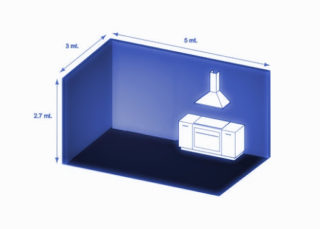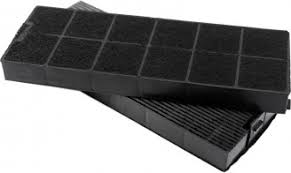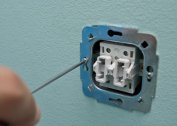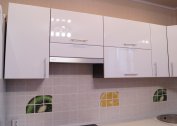When choosing a suitable model of an exhaust device for the kitchen, attention is paid not only to its design or to its branded accessories. Do not forget about such an important parameter for air purification as the power of hoods for kitchens (or their performance). Without a correct assessment of this indicator, even a very attractive-looking unit from a well-known manufacturer is unlikely to be able to effectively clean the air in the house from the accumulated vapor in it. How much contaminated air masses can be pumped over a given period of time depends on its performance. A competent calculation of the hood necessarily precedes a trip to the store and its purchase.
Types of hoods for the kitchen
In the domestic market there is a large assortment of ventilation products of a very different class. It takes into account the features of the kitchen and the design of the exhaust device itself. Among the presented samples on these grounds, the following executions are distinguished:
- dome model;
- hidden in items of furniture;
- telescopic;
- flat.
- T-shaped (island) or box-shaped.
The first type of exhaust structure is mounted directly above the stove, forming something like a dome that draws in air. It has significant dimensions and has an attractive appearance, reminiscent of an expensive fireplace. A hidden variant of hoods refers to practical models that can be built directly into kitchen furniture. Its owner can see only a small part of the product with a remote control panel.
The internal space of the cabinet in which such a device is mounted may be used for other purposes. This type of kitchen ventilation is represented by relatively inexpensive models suitable for users who want to save on the space occupied by the equipment. Telescopic hoods are also mounted covertly; to bring them into working position, it is enough to push the panel out with the grease filters mounted in it.
Flat designs operate in the natural circulation mode of air masses through connected ducts and belong to the simplest devices of this class. Installation of such systems, as a rule, does not cause difficulties, since they do not need to be connected to the existing ventilation system. They are suspended directly above the stove parallel to the wall.
Island or T-shaped appliances are designed for large kitchens or with ventilation systems combined with the bathroom. They are mounted on the walls or ceiling directly above the stove and are characterized by a fairly high power indicator. Boxed models that look like a pipe or steel box and eliminate odors in the kitchen and bathroom are also in this category.
Design and principle of operation
When considering the design of exhaust structures, it is important to pay attention to the fact that they, in principle, differ from ventilation systems. The latter are niches arranged in the walls, allowing you to remove the exhaust air out in a natural way. The inflow of fresh air masses in this case is possible only through gaps in the door and window openings.This method of air exchange is characterized by low efficiency and is not able to completely remove odors present in the kitchen, as well as remove soot and other household fumes. For these purposes, you will need special devices that provide forced ventilation and called hoods. With their help, the vapors emanating from the hob or stove are collected in one place, and then, through a special duct, are led out through the ventilation ducts.
Principle of operation
In accordance with this factor, all devices offered by the market are divided into three types:
- recirculation (without outlet to the existing ventilation);
- flowing;
- combined.
Hoods without exhaust to the ventilation duct contain special filters and a forced intake system through the built-in fan. During operation, they pass contaminated air through a system of filter elements, and after cleaning it is returned back to the kitchen.
Flowing models are connected directly to the existing duct in the kitchen. Fresh air enters through it, after which the contaminated layers are removed by force. Devices of a combined type are capable of alternately operating in one of the two modes discussed above.
Hoods of various modifications
Modern exhaust products are made in several designs that determine their purpose. Depending on this, they are divided into hoods, which allow only to remove dirty air, as well as models that filter it and return it back to the system in an already cleaned form. Flowing devices contain a set of soft plastic or hard metal pipes of a certain shape. They are used to connect to the ventilation system.
In the lower part of such products there are special filters (grease traps) that delay soot and grease emanating from the stoves. From above, they are masked by special decorative panels, and in the inner area there are fans and a drive motor. Behind these structural elements is an air duct connected directly to the ventilation.
Since recirculation devices operate autonomously, they are devoid of outlet pipes and are more aesthetically pleasing. In their internal space immediately after the fans there are replaceable thin filters. In terms of design, they differ little from their flow-through counterparts, except for the fact that their operation requires connection to an electric network. The most convenient hood models in this regard, equipped with touch displays and having a remote control.
Regulatory requirements
Existing sanitary standards define the requirements for kitchen hoods without being tied to specific models. At the same time, they proceed from the fact that they are not intended to organize ventilation of the room, but serve solely to remove contaminated air from the stove. The ceiling area is also unavailable for them, which forces them to choose a model that can only serve the space above the hob, for example, or above a conventional gas stove.
The performance of the hoods is aligned with the requirements of sanitation as follows:
- An indicator of effective work is the mode when the air in the kitchen is updated at least 10 times in one hour.
- The average indicator for various rooms used in the calculations is selected from the range of 10-15 times.
- For typical kitchens, it is taken equal to 12 units.
If the owners constantly smoke in this place, the required performance of the unit increases by 15-30 percent.
Recommended Power
The power of cooker hoods or their performance is an indicator of how effectively the device cleans the air in the room. This parameter is expressed in cubic meters of air mass passed through them for a fixed time. When determining it, they proceed from the current sanitary norms and the requirements of SNiP.
With the right selection of a model with the necessary power, the costs of its acquisition over time will fully pay off due to the rejection of detergents and medical preparations. When calculating this indicator, it is important not to make a mistake in one of the parties. It is recommended to calculate the hood power for a kitchen, taking into account factors that actively influence its size.
Calculation of hood power
As the simplest option, performance calculations use the formulaP = SxHx12, Where
- P - the desired power indicator;
- S - the area of the kitchen;
- H - ceiling height.
The number 12 corresponds to the normalized coefficient of air renewal.
This formula is applicable only for rooms up to 40 m³. With its help, it is very simple to calculate the minimum power of the exhaust equipment. However, the actual amount of intake air depends on many indicators, including:
- type of source of pollution;
- ventilation system design;
- layout of the kitchen itself;
- hood installation location;
- way to organize the flow of air masses.
In this case, the exhaust device does not replace a missing ventilation system.
As an example, the hood power for a kitchen with an area of about 12 square meters will be calculated. In accordance with the formula, the necessary equipment characteristics are first determined. In this case, the following initial data are taken:
- The kitchen area is 12 square meters. m (3x4 meters).
- Ceiling height of about 2.7 meters.
- The number of people living is 3 people.
In addition, a hob is installed in the kitchen, which is turned on at least 3 times a day, and there is a separate air outlet.
To calculate the performance of the exhaust device for the kitchen, you will need to substitute the indicated numbers in the formula, after calculating which it turns out:
P = (3x4) x2.7x12x1.5 = 583.2 m³ / h.
1.5 is a coefficient taken for an electric stove and taking into account the design features of the equipment. It turns out that the optimal exhaust hood performance for such a kitchen is at least 600 m³ / h. It will not be difficult to find a model suitable for the calculated indicator on the market.
Noise level and other important characteristics
During their work, any model of hoods produce extraneous sounds. If you hear a noise similar to rattling or vibration, this indicates that there is a backlash in some place - the case or the duct is loose. When the fan blades are very dirty, you will hear the characteristic hum of the exhaust system.
Since the engine that rotates the fan blades also works when the hood is activated, this process is also accompanied by a clearly distinguishable buzz. By the nature of the sounds made during the operation of the system, some users manage to understand which node they are connected to and whether the latter needs to be cleaned.
The most important characteristics of exhaust devices also include:
- dimensions of the used unit;
- its power;
- a method of cleaning air masses;
- the presence of a built-in filter and fan.
Knowing all these parameters will allow the interested user to easily choose the model suitable for his kitchen.
Rules for choosing a hood for the kitchen
When choosing an exhaust device, first of all, its dimensions are taken into account, given by the dimensions of the stove or hob. If we take into account that their width is in the range of 45-90 cm, manufacturers offer models with a fixed number of parameters (50, 60, 90 and 120 cm).In addition, attention is drawn to the installation height of the hood. According to current standards, it is supposed to hang it at a distance of 0.75 meters from the surface of the pollution source.
The performance of the purchased device should be sufficient to clean the polluted air, taking into account the number of people living in the house. You should also ask what filters are built into the selected model.
Acquiring recirculation units with carbon filters makes sense for rooms in which it is not possible to connect to the existing ventilation.










